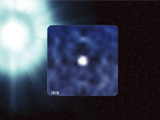|
|
TODAY.AZ / Weird / Interesting
Quantum 'Graininess' of space at smaller scales? Gamma-ray observatory challenges physics beyond Einstein
04 July 2011 [12:27] - TODAY.AZ
 The European Space Agency's Integral gamma-ray observatory has provided results that will dramatically affect the search for physics beyond Einstein. It has shown that any underlying quantum 'graininess' of space must be at much smaller scales than previously predicted.
The European Space Agency's Integral gamma-ray observatory has provided results that will dramatically affect the search for physics beyond Einstein. It has shown that any underlying quantum 'graininess' of space must be at much smaller scales than previously predicted.Einstein's General Theory of Relativity describes the properties of gravity and assumes that space is a smooth, continuous fabric. Yet quantum theory suggests that space should be grainy at the smallest scales, like sand on a beach.
One of the great concerns of modern physics is to marry these two concepts into a single theory of quantum gravity.
Now, Integral has placed stringent new limits on the size of these quantum 'grains' in space, showing them to be much smaller than some quantum gravity ideas would suggest.
According to calculations, the tiny grains would affect the way that gamma rays travel through space. The grains should 'twist' the light rays, changing the direction in which they oscillate, a property called polarisation.
High-energy gamma rays should be twisted more than the lower energy ones, and the difference in the polarisation can be used to estimate the size of the grains.
Philippe Laurent of CEA Saclay and his collaborators used data from Integral's IBIS instrument to search for the difference in polarisation between high- and low-energy gamma rays emitted during one of the most powerful gamma-ray bursts (GRBs) ever seen.
GRBs come from some of the most energetic explosions known in the Universe. Most are thought to occur when very massive stars collapse into neutron stars or black holes during a supernova, leading to a huge pulse of gamma rays lasting just seconds or minutes, but briefly outshining entire galaxies.
GRB 041219A took place on 19 December 2004 and was immediately recognised as being in the top 1% of GRBs for brightness. It was so bright that Integral was able to measure the polarisation of its gamma rays accurately.
Dr Laurent and colleagues searched for differences in the polarisation at different energies, but found none to the accuracy limits of the data.
Some theories suggest that the quantum nature of space should manifest itself at the 'Planck scale': the minuscule 10-35 of a metre, where a millimetre is 10-3 m.
However, Integral's observations are about 10 000 times more accurate than any previous and show that any quantum graininess must be at a level of 10-48 m or smaller.
"This is a very important result in fundamental physics and will rule out some string theories and quantum loop gravity theories," says Dr Laurent.
Integral made a similar observation in 2006, when it detected polarised emission from the Crab Nebula, the remnant of a supernova explosion just 6500 light years from Earth in our own galaxy.
This new observation is much more stringent, however, because GRB 041219A was at a distance estimated to be at least 300 million light years.
In principle, the tiny twisting effect due to the quantum grains should have accumulated over the very large distance into a detectable signal. Because nothing was seen, the grains must be even smaller than previously suspected.
"Fundamental physics is a less obvious application for the gamma-ray observatory, Integral," notes Christoph Winkler, ESA's Integral Project Scientist. "Nevertheless, it has allowed us to take a big step forward in investigating the nature of space itself."
Now it's over to the theoreticians, who must re-examine their theories in the light of this new result.
/Science Daily/
URL: http://www.today.az/news/interesting/89665.html
 Print version
Print version
Views: 1962
Connect with us. Get latest news and updates.
See Also
- 19 February 2025 [22:20]
Visa and Mastercard can return to Russia, but with restrictions - 05 February 2025 [19:41]
Japan plans to negotiate with Trump to increase LNG imports from United States - 23 January 2025 [23:20]
Dubai once again named cleanest city in the world - 06 December 2024 [22:20]
Are scented candles harmful to health? - 23 November 2024 [14:11]
Magnitude 4.5 earthquake hits Azerbaijan's Lachin - 20 November 2024 [23:30]
Launch vehicle with prototype of Starship made its sixth test flight - 27 October 2024 [09:00]
Fuel prices expected to rise in Sweden - 24 October 2024 [19:14]
Turkiye strikes terror targets in Iraq and Syria - 23 October 2024 [23:46]
Kazakhstan supplied almost entire volume of oil planned for 2024 to Germany in 9 months - 23 October 2024 [22:17]
Taiwan reported passage of Chinese Navy aircraft carrier near island
Most Popular
 What von der Leyen doesn't know about. Or doesn't want to know
What von der Leyen doesn't know about. Or doesn't want to know
 Culture Minister meets with Kyrgyz counterpart in Bishkek
Culture Minister meets with Kyrgyz counterpart in Bishkek
 Japan grants $3 billion loan to Ukraine using profits from frozen Russian assets
Japan grants $3 billion loan to Ukraine using profits from frozen Russian assets
 America’s tariff strategy risks fragmenting global economy
America’s tariff strategy risks fragmenting global economy
 At least 148 dead after boat accident on DR Congo river
At least 148 dead after boat accident on DR Congo river
 Uzbekistan, South Korea discuss easing visa rules, expanding seasonal work opportunities
Uzbekistan, South Korea discuss easing visa rules, expanding seasonal work opportunities
 Trump sees hope for Ukraine-Russia deal, analysts remain skeptical
Trump sees hope for Ukraine-Russia deal, analysts remain skeptical
